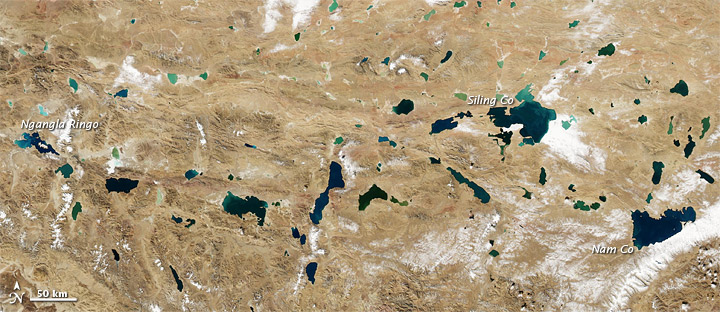


The Qinghai-Tibet Plateau not only gives rise to most of Asia’s major rivers, it also holds a constellation of salt- and freshwater lakes. Due to differences in depth, sediments, and microscopic organisms in the various lakes, they collectively present a myriad of greens, blues, and teals when viewed from above.
The Moderate Resolution Imaging Spectroradiometer (MODIS) on NASA’s Aqua satellite captured this natural-color image of the Tibetan Plateau on November 10, 2010. Resembling bits of abalone shell, the lakes glimmer in assorted jewel tones. (Visit the Ocean Color Web for a collage of lakes on the plateau.)
The lakes in this region typically lack outlets, allowing the accumulation of minerals that, combined with other features, influence lake color. The lakes vary widely in surface area and shape. Two of the largest in this scene are Siling Co and Nam Co. One of the most irregularly shaped lakes is Ngangla Ringco.
Nam Co ranks among the world’s highest-altitude salt lakes, with a lake surface at 4,718 meters (15,480 feet). It measures roughly 79 by 25 kilometers (49 by 16 miles) and, except for areas along the southwestern and northeastern margins, the lake appears nearly uniform blue. Measurements conducted in 2006 found that half of this lake was more than 90 meters (300 feet) deep. Inflow rivers deliver water from glaciers, and studies have found the water level was rising between 1976 and 2001, and in 2005 and 2006.
Siling Co’s shape and color vary more than Nam Co’s. The lake’s blue-green hue ranges from light (in the north and east) to dark (in the south and west). Fringing the lake are smaller water bodies, which all used to be part of a larger lake. Today, Siling Co measures about 78 by 21 kilometers (48 by 13 miles), with an altitude of 4,530 meters (14,860 feet). This salt lake is replenished mostly by surface runoff. Like Nam Co, this lake gained water during the late twentieth century, rising between 1976 and 1999.
Lying to the west, Ngangla Ringco is one of the most unusually shaped water bodies on the Qinghai-Tibet Plateau, with colors ranging from turquoise to sapphire. Small islands dot the surface in the west, and a large island sits in the lake’s eastern half. This salt lake measures approximately 57 by 9 kilometers (35 by 6 miles). Ngangla Ringo lies at a lower altitude than Nam Co and Siling Co, with a surface altitude of just 1,689 meters (5,540 feet).
Unlike those larger lakes, Ngangla Ringo shrank between 1977 and 1999. In that respect, Ngangla Ringo more closely resembles other Tibetan lakes. A study published in 2008 found that most lakes of the Qinghai-Tibet Plateau were losing water.
NASA Earth Observatory image created by Jesse Allen, using data obtained from the Goddard Level 1 and Atmospheric Archive and Distribution System (LAADS). Caption by Michon Scott with input from Norman Kuring, Goddard Space Flight Center.